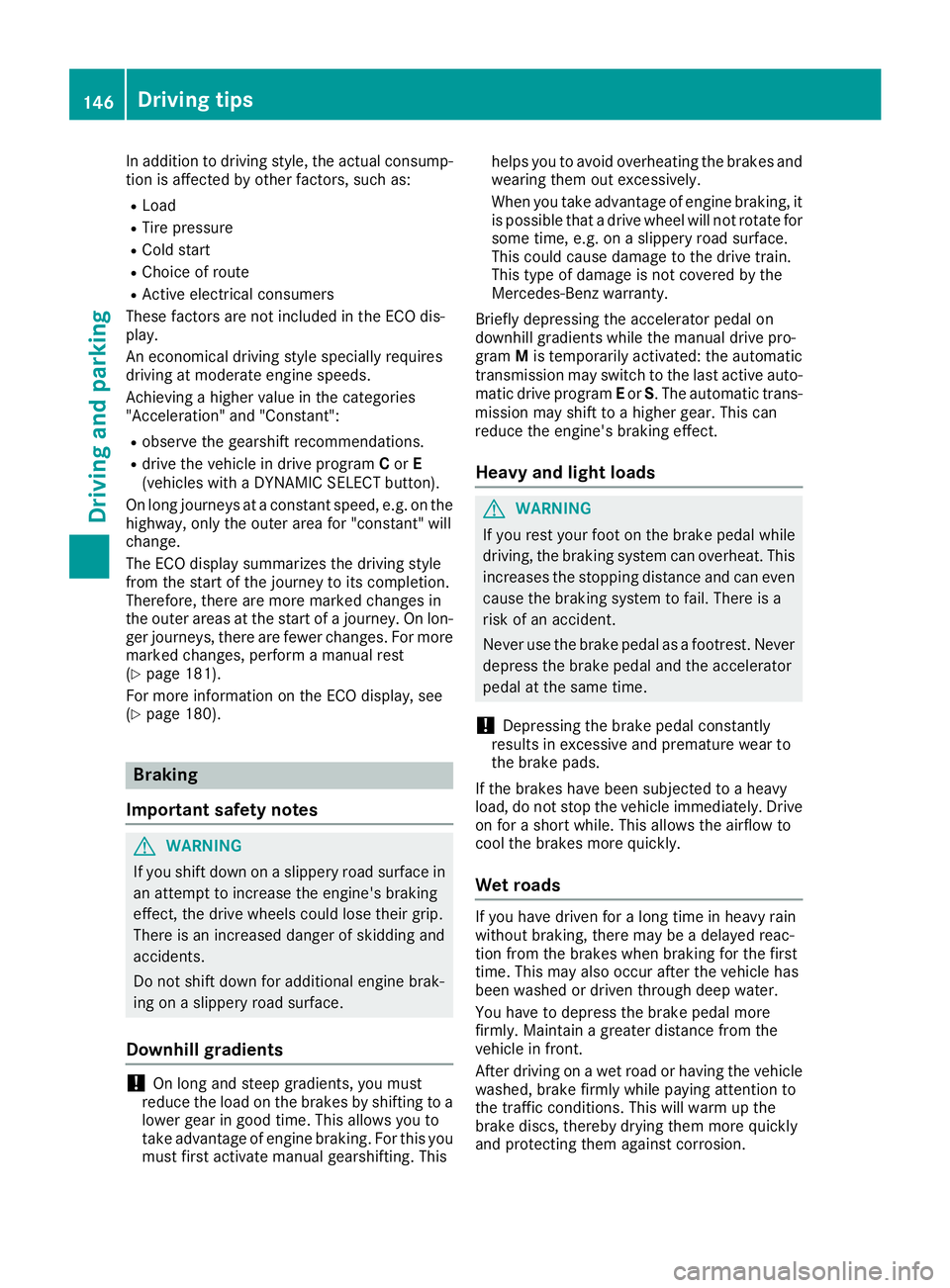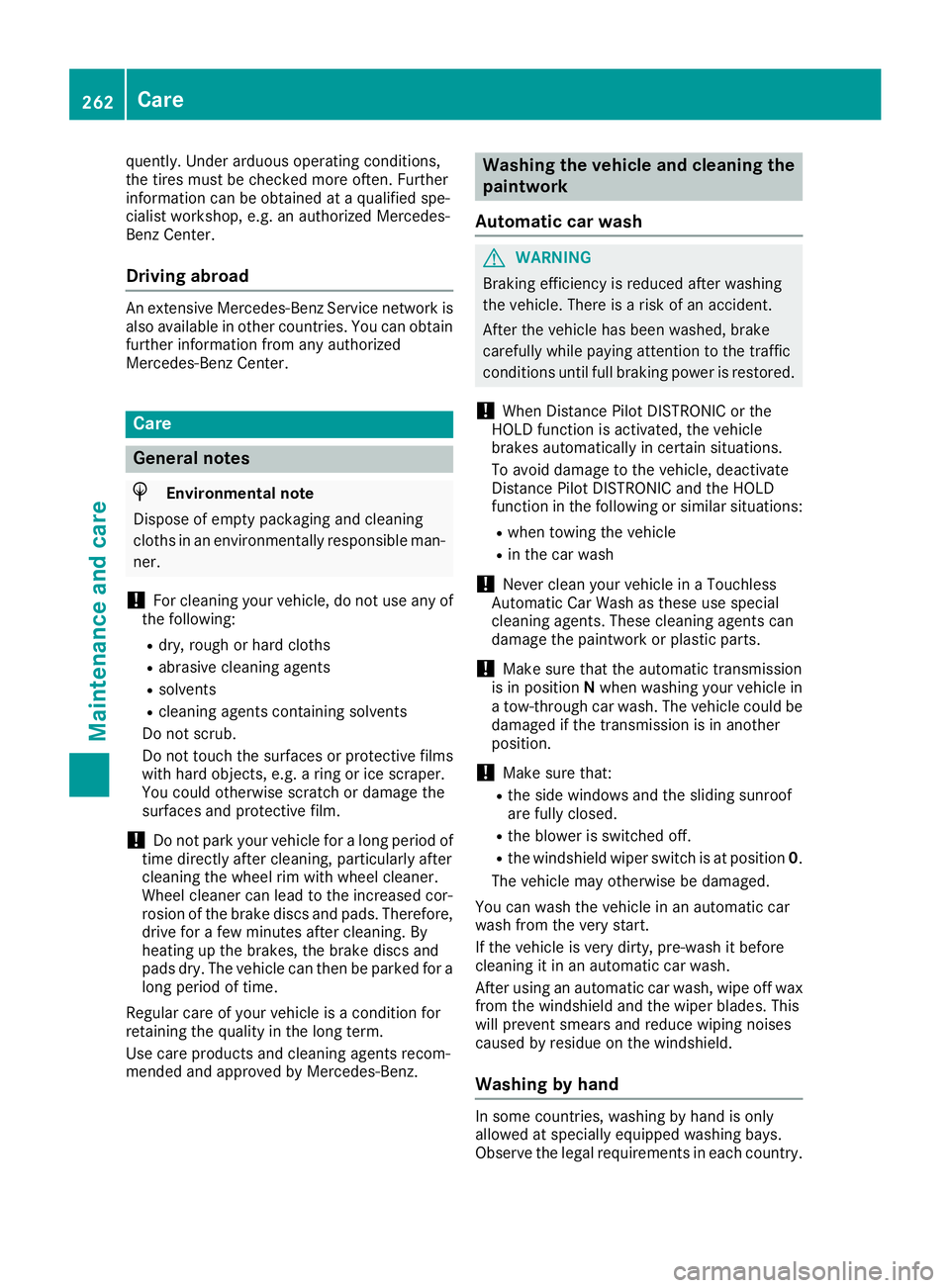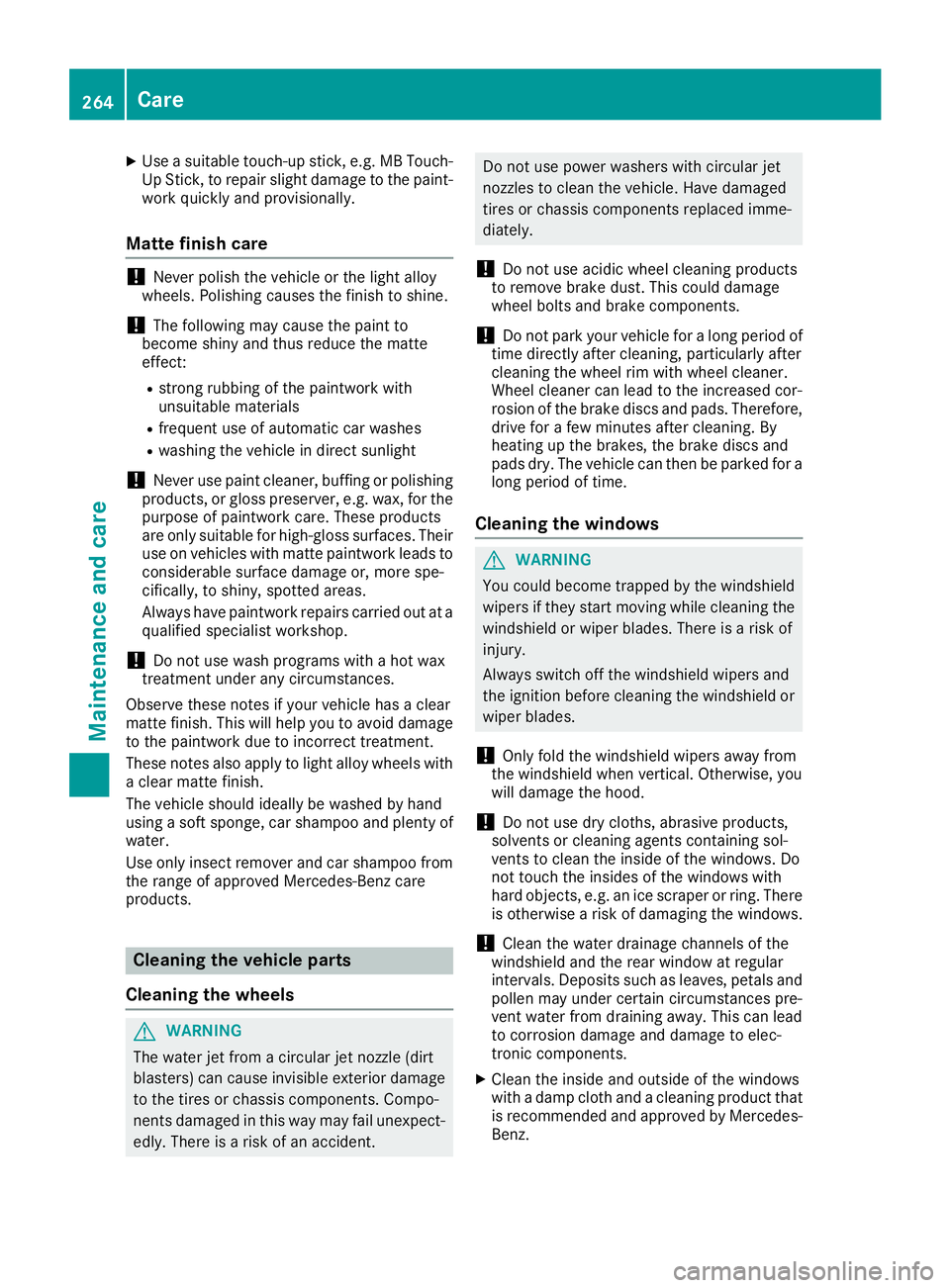2018 MERCEDES-BENZ CLA brake pads
[x] Cancel search: brake padsPage 123 of 326

Note sonb reaking-in an ew vehicle
Important safety notes Th es en so rs ys te mofs om ed riving and driving
safety systems adjusts automaticall yw hile a
certai nd is tance is being driven after the vehicle
ha sb ee nd elivere dora ft er repairs. Full system
effectiveness is not reache du nti lt he end of this
teach-i np rocedure.
New and replaced brake pads and discs only
reach their optimum braking effect after several
hundred kilometers of driving. Compensate for
thi sb ya pplyin gg reate rf orce to the brake pedal.
The first 1000 miles (150 0k m)Th em or ey ou look after the engine when it is
new ,t he mor es at isfied yo uw il lbew it hi ts per-
formance in the future. R
Yo us houl dt herefore drive at varying vehicle
and engine speeds for the first 1000 miles
(1500 km). R
Avoi dh eavy loads, e.g .d riving at full throttle,
during thi sp eriod.R
Chang eg ea ring oo dt ime, befor et he tach-
ometer needl ei s �
Page 148 of 326

In addition to driving style, the actual consump-
tion is affected by other factors, such as: R
Load R
Tire pressure R
Cold start R
Choice of route R
Active electrical consumers
These factors are not include dint he ECO dis-
play.
An economical driving style specially requires
driving at moderate engine speeds.
Achieving ah igher valu eint he categories
"Acceleration" and "Constant": R
observe the gearshift recommendations. R
drive the vehicle in drive program C or E
(vehicles with aD YNAMIC SELECT button).
On long journeys at ac onstant speed ,e .g. on the
highway, only the outer area for "constant" will
change.
The ECO display summarizes the driving style
from the start of the journey to its completion.
Therefore, there are more marked changes in
the outer area satt he start of aj ourney. On lon-
ger journeys, there are fewer changes. For more
marked changes, perform am anua lr est
( Y
page 181).
For more information on the ECO display, see
( Y
page 180).
Braking
Important safety notes
G WARNING
If you shift down on as lippery road surface in
an attempt to increase the engine's braking
effect, the drive wheel sc ould lose their grip.
There is an increased danger of skidding and
accidents.
Do not shift down for additional engine brak-
ing on as lippery road surface.
Downhill gradients
! On long and steep gradients, you must
reduce the load on the brakes by shifting to a
lowe rg ear in good time. This allows you to
take advantage of engine braking. For this you
must first activate manua lg earshifting. This helps you to avoid overheating the brakes and
wearing them out excessively.
When you take advantage of engine braking, it
is possible that ad rive wheel wil ln ot rotate for
some time, e.g. on as lippery road surface.
This could cause damage to the drive train.
This type of damage is not covered by the
Mercedes-Benz warranty.
Briefly depressing the accelerator peda lo n
downhill gradients whil et he manua ld rive pro-
gram M is temporaril ya ctivated: the automatic
transmission may switch to the last active auto-
matic drive program E or S .T he automatic trans-
missio nm ay shift to ah ighe rg ear. This can
reduce the engine's braking effect.
Heavy and light loads
G WARNING
If you rest you rf oot on the brake peda lw hile
driving, the braking system can overheat. This
increases the stopping distance and can even
cause the braking system to fail .T here is a
risk of an accident.
Never use the brake peda lasaf ootrest. Never
depres st he brake peda la nd the accelerator
peda latt he same time.
! Depressing the brake peda lc onstantly
results in excessive and premature wea rt o
the brake pads.
If the brakes have been subjected to ah eavy
load ,don ot stop the vehicle immediately .D rive
on for as hort while. This allows the airflow to
cool the brakes more quickly.
Wet roads If you have driven for al ong time in heavy rain
withou tb raking, there may be ad elayed reac-
tion from the brakes when braking for the first
time. This may also occur after the vehicle has
been washed or driven through deep water.
You have to depres st he brake peda lm ore
firmly .M aintai nag reater distance from the
vehicle in front.
After driving on aw et road or having the vehicle
washed, brake firmly whil ep aying attention to
the traffic conditions. This wil lw arm up the
brake discs, thereby drying them more quickly
and protecting them against corrosion.146
Driving tips
Driving and parking
Page 149 of 326

Limited braking performance on salt-
treated roads If you driv eons alted roads ,al ayer of salt resi-
due may for mont he brak ed isc sa nd brake
pads. This can result in as ignificantly longer
braking distance. R
In orde rtop revent any salt build-up, apply the
brakes occasionally while paying attention to
th et ra ffic conditions.R
Carefully depress th eb rak ep edal and the
beginnin ga nd end of aj ou rney.R
Maintain ag reater distanc etot he vehicle
ahead.
Servicing th eb rakes
! The brak ef luid level may be to ol ow, if:R
if th er ed brak ew arning lamp light supi n
th ei nstrumen tc luster andR
you hear aw arning tone while th ee ngine is
running
Observe additional warning messages in the
multifunction display.
The brak ef luid level may be to ol ow due to
brak ep ad wear or leaking brak el ines.
Hav et he brak es ystem checked immediately.
Consult aq ualifie ds pecialist workshop to
arrange this.
! Af unction or performanc et es ts hould only
be carried out on a2 -a xle dynamometer. If
you wish to operate th ev ehicle on such a
dynamometer, please consult aq ualifie ds pe-
cialis tw orkshop in advance. You could oth-
erwis ed amage th ed riv et ra in or th eb rake
system.
! As th eE SP ®
system operates automatically,
th ee ngine and th ei gnitio nm ust be switched
off (th eS ma rtKey must be in position �
Page 264 of 326

quently. Under arduous operatin gc onditions,
the tires must be checked more often. Further
information can be obtained at aq ualified spe-
cialist workshop, e.g. an authorized Mercedes-
Ben zC enter.
Driving abroad An extensive Mercedes-Benz Service network is
also available in other countries. You can obtain
further information from any authorized
Mercedes-Benz Center.
Care
General notes
H Environmental note
Dispose of empty packagin ga nd cleaning
cloths in an environmentally responsible man-
ner.
! For cleanin gy our vehicle, do not use any of
the following: R
dry, rough or hard cloths R
abrasive cleanin ga gentsR
solvents R
cleanin ga gent sc ontainin gs olvents
Do not scrub.
Do not touch the surfaces or protective films
with hard objects, e.g. ar ing or ice scraper.
You could otherwise scratch or damage the
surfaces and protective film.
! Do not park your vehicle for al ong period of
time directly after cleaning, particularly after
cleanin gt he wheel rim with wheel cleaner.
Wheel cleaner can lead to the increased cor-
rosion of the brake discs and pads. Therefore,
drive for af ew minutes after cleaning. By
heating up the brakes, the brake discs and
pads dry. The vehicle can then be parked for a
long period of time.
Regular care of your vehicle is ac ondition for
retaining the quality in the long term.
Use care product sa nd cleanin ga gent sr ecom-
mended and approved by Mercedes-Benz. Washing the vehicle and cleaning the
paintwork
Automatic car wash
G WARNING
Braking efficiency is reduced after washing
the vehicle. There is ar isk of an accident.
After the vehicle has been washed, brake
carefully while paying attention to the traffic
condition su ntil full brakin gp ower is restored.
! When Distance Pilot DISTRONIC or the
HOLD function is activated, the vehicle
brakes automatically in certain situations.
To avoid damage to the vehicle, deactivate
Distance Pilot DISTRONIC and the HOLD
function in the following or similar situations: R
when towing the vehicle R
in the car wash
! Never clean your vehicle in aT ouchless
Automatic Car Wash as these use special
cleanin ga gents. These cleanin ga gent sc an
damage the paintwor korp lastic parts.
! Make sure that the automatic transmission
is in position N when washing your vehicle in
at ow-through car wash. The vehicle could be
damaged if the transmission is in another
position.
! Make sure that: R
the side windows and the sliding sunroof
are fully closed. R
the blower is switched off. R
the windshield wiper switch is at position 0 .
The vehicle may otherwise be damaged.
You can wash the vehicle in an automatic car
wash from the very start.
If the vehicle is very dirty, pre-wash it before
cleanin gitinana utomatic car wash.
After using an automatic car wash, wipe off wax
from the windshield and the wiper blades. This
will preven ts mears and reduce wiping noises
caused by residue on the windshield.
Washing by hand
In some countries, washing by hand is only
allowed at specially equipped washing bays.
Observe the legal requirements in each country.262
Care
Maintenance and care
Page 266 of 326

X
Use as uitabl et ouch-up stick, e.g. MB Touch-
Up Stick ,tor epair slight damage to the paint-
work quickly and provisionally.
Matt ef inish care
! Never polish the vehicle or the light alloy
wheels. Polishing causes the finish to shine.
! The following may cause the paint to
become shiny and thus reduce the matte
effect: R
strong rubbing of the paintwork with
unsuitabl em aterialsR
frequent use of automatic car washes R
washing the vehicle in direct sunlight
! Never use paint cleaner, buffing or polishing
products, or gloss preserver, e.g. wax, for the
purpose of paintwork care. These products
are only suitabl ef or high-gloss surfaces. Their
use on vehicles with matte paintwork leads to
considerable surface damage or, more spe-
cifically ,tos hiny, spotted areas.
Alway sh ave paintwork repairs carried out at a
qualified specialist workshop.
! Do not use wash programs with ah ot wax
treatment under any circumstances.
Observe these notes if your vehicle has ac lear
matte finish. This will help you to avoid damage
to the paintwork due to incorrect treatment.
These notes also apply to light alloy wheels with
ac lear matte finish.
The vehicle should ideally be washed by hand
using as oft sponge, car shampoo and plenty of
water.
Use only insect remover and car shampoo from
the range of approved Mercedes-Benz care
products.
Cleaning the vehicl ep arts
Cleaning the wheels
G WARNING
The water jet from ac ircular jet nozzle (dirt
blasters) can cause invisible exterior damage
to the tires or chassis components. Compo-
nent sd amage dint his way may fail unexpect-
edly .T here is ar isk of an accident. Do not use power washers with circular jet
nozzles to clean the vehicle. Have damaged
tires or chassis component sr eplaced imme-
diately.
! Do not use acidic wheel cleaning products
to remove brake dust. This could damage
wheel bolts and brake components.
! Do not park your vehicle for al ong period of
time directly after cleaning, particularl ya fter
cleaning the wheel rim with wheel cleaner.
Wheel cleaner can lead to the increased cor-
rosion of the brake discs and pads. Therefore,
drive for af ew minutes after cleaning. By
heating up the brakes, the brake discs and
pads dry. The vehicle can then be parked for a
long period of time.
Cleaning the windows
G WARNING
You could become trapped by the windshield
wipers if they start moving while cleaning the
windshiel dorw iper blades. There is ar isk of
injury.
Alway ss witch off the windshiel dw ipers and
the ignition before cleaning the windshiel do r
wiper blades.
! Only fold the windshiel dw ipers awa yf rom
the windshiel dw hen vertical. Otherwise, you
will damage the hood.
! Do not use dry cloths, abrasive products,
solvents or cleaning agents containing sol-
vents to clean the inside of the windows. Do
not touch the insides of the windows with
hard objects, e.g. an ice scraper or ring. There
is otherwise ar isk of damaging the windows.
! Clea nt he water drainage channels of the
windshiel da nd the rear window at regular
intervals. Deposits such as leaves, petals and
pollen may under certain circumstances pre-
vent water from draining away. This can lead
to corrosion damage and damage to elec-
tronic components. X
Clea nt he inside and outside of the windows
with ad amp cloth and ac leaning product that
is recommended and approved by Mercedes-
Benz.264
Care
Maintenance and care